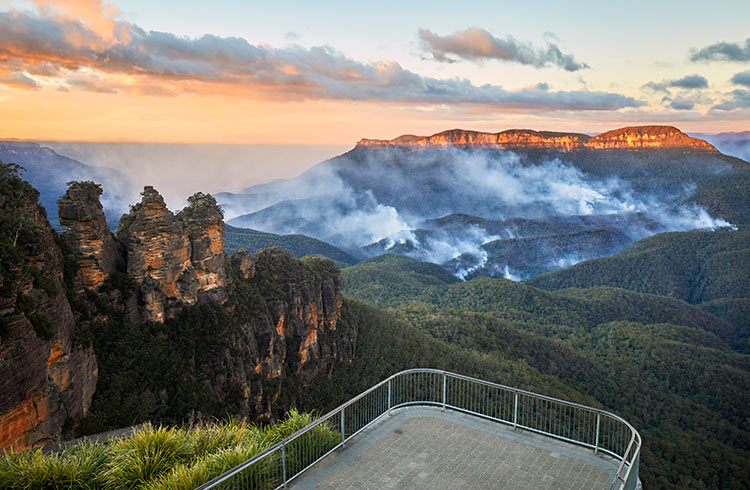Post-Disaster Travel: Helping Communities Recover
Traveling to destinations in need – after the acute phase of a disaster has passed – can make a big difference, but here's what to know before you start packing.
 Photo © Getty Images / Andrew Merry
Photo © Getty Images / Andrew Merry
Wildfires, mega-storms, earthquakes and floods in tourism-reliant parts of the world often face a second wave of devastation once the initial emergency of a natural disaster has subsided – the long-lasting loss of income.
A destination’s reputation as an idyllic place to vacation or explore can be negatively impacted, often unfairly and for far longer than is warranted, following media reports of raging fires, damaging flood waters or people in distress. Social media then serves to amplify events with off-putting – and shareable – photos and videos shot at the height of a disaster.
Travel dollars matter
While it is not advisable to head for the nearest site of a natural disaster in full fury (unless you are a qualified disaster relief professional invited to lend a hand in emergency operations, you will definitely be more of a hindrance than a help), traveling there as soon as it’s safe to do so can be a big help to disaster-impacted communities struggling to bounce back.
“Time and again, tourism has proven itself as a pillar of resilience and a driver of economic recovery,” says Zhu Shanzhong, executive director of the United Nations World Tourism Organisation (UNWTO).
The UNWTO reports that tourism now supports 1 in 10 jobs worldwide, and that there are almost 1.5 billion international traveler arrivals (and rising) each year. Tourism has never been more relied upon.
Destination dismissal
Natural disasters can destroy the very features of the landscape and environment that make a destination so appealing to travelers, but it’s important to recognize that the destruction is often contained to a small area. There may be no need to avoid a whole country or region when only a portion of it has been affected.
Hurricanes regularly sweep through the Caribbean islands, for example, but a hurricane may cause minimal damage or leave untouched all but the islands unlucky enough to be directly in its path. Even if an island is hit, it may be a glancing blow that leaves one side of an island in tatters and the other unharmed. If airports and roads leading to where you want to go aren’t damaged, there may be no reason to stay away.
Other areas affected by disasters such as flooding can return to normal in a surprisingly short amount of time.
In 2019, Venice was hit by the worst flooding it has faced in 50 years, inundating much of the city and sending travelers scurrying for dry land. The unusually high tide soon subsided, however, and so reliant is the city on tourism that locals appealed to visitors to return – a turnaround in sentiment for a European hotspot usually so overrun by visitors that it causes resentment.
Kindness of strangers
It’s pretty simple, really. The money you spend on accommodation, shopping and dining is a big help to communities rebuilding after a disaster, especially those that rely heavily on tourism. And it’s rewarding to know you’re helping in their recovery.
Upliftingly, once people know it’s safe to return to a destination – and that their presence would be helpful – many are happy to oblige. In Australia’s Blue Mountains, calls for support following the 2019/2020 wildfires that wiped out two-thirds of the area’s Heritage-listed national park, were met with enthusiasm.
Weekenders from Sydney, 90 minutes away, made their way to the towns of the Blue Mountains in droves, buoying community spirit and filling the empty cash registers of shops and cafes. Overseas visitor numbers will, however, take far longer to return to normal and now that the crisis is fading from memory, fewer Sydneysiders are thinking to visit.
Safety first
In some tourism-reliant communities, recovery is painfully slow and it can take years to rebuild what was lost – reputation included. In 2010, a devastating earthquake in Haiti destroyed most of the capital, Port-au-Prince, and claimed an estimated 200,000 lives. A decade on, the situation in Haiti is still chaotic, with challenges far too great to be met by well-intentioned visitors.
Anywhere that infrastructure such as roads or communications networks are badly damaged is often also less safe to travel around. Large-scale, long-term and structured responses are underway in Haiti but it may be another 10 years before tourists can be safely welcomed there again.
In 2018, a boys’ football team was stranded in a flooded cave network at Tham Luang Nang Non, Thailand. Eighteen months later, in 2019, the area has transitioned from danger zone to thriving travel destination, bringing in welcome funding.
In the early days of the crisis, a base camp of tents and other temporary shelters sprang up at the mouth of the cave. This was necessary to keep onlookers at a safe distance from the rescue work being carried out.
"It took a little more than a year to open the cave because we had to rearrange the landscape and ensure that the Tham Luang Cave was able to accommodate an influx of tourists," said Jongklai Worapongsathork, deputy director-general of National Parks, Wildlife and Plant Conservation.
With the priority to make the area safe for visitors, the decision was made to limit how many people could enter the cave. "We allow only 20 people at a time to see the three significant spots in the cave," Worapongsathork said.
The Albanian government is hoping a similar influx of travelers will assist Albania’s recovery after a 6.4-magnitude earthquake killed 51 people and damaged buildings, infrastructure and businesses in 2019. Not two months later, the government had organized an international conference to discuss how best to encourage overseas visitors to return.
Before you go
If you’d like to help a destination recover post-disaster, ask yourself:
• Is it safe?
• Is it a useful time to go?
• What kind of activities do I picture myself doing there?
• Will I harm anyone by just being there?
Remember that a post-disaster context is by definition a place where people are vulnerable, and visitors should be sensitive to the situation. Tour companies offering to take you to disaster-stricken areas for a look should be avoided. No one likes to be made into a spectacle.
If you’re looking for volunteering opportunities on your travels, research is needed to ensure you’re not inadvertently exploiting or otherwise harming the people you want to help.
Always check that the organization you plan to support is officially recognized and publishes information about how it’s funded and run. Giving them your precious time and commitment is a big deal! The latest annual report on its website should quickly tell you what you need to know and will either inspire you to get packing or have you running a mile.
Once you start looking, you’re likely to find lots of options: places to go where you can ‘give back’ a little while enjoying a break. Whilst you may not have the chance to visit every destination in need, consider holding a fundraiser or making a donation to emergency or recovery funds run by reputable organizations. You’ll feel great knowing your contribution is helping communities get back on their feet more quickly, even without your presence.
Related articles
Simple and flexible travel insurance
You can buy at home or while traveling, and claim online from anywhere in the world. With 150+ adventure activities covered and 24/7 emergency assistance.
Get a quote


No Comments